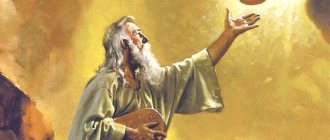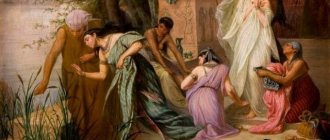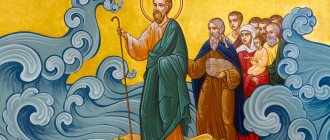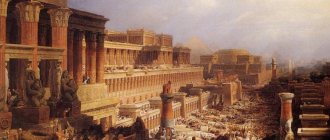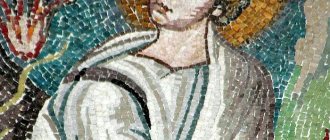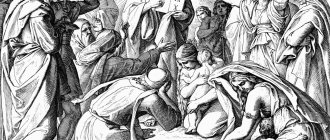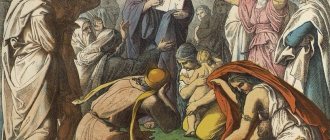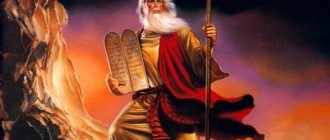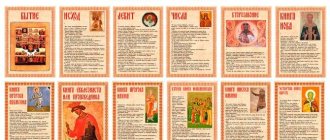The book of Exodus tells us that God gave the Tablets to the Jews through Moses.
We know about the Tablets from the book of Exodus. The biblical background is like this. The descendants of the patriarch of Israel moved to the Egyptian lands, where over time they became slaves oppressed by the Egyptians.
The nameless pharaoh really did not want to release the Jewish people from slavery, although Moses (not the last person at the Egyptian court) strongly recommended this.
In the end, everything turned out very badly for the Egyptian people - 10 Egyptian executions occurred.
Moses with the Tablets on an Orthodox icon. Photo: ikona-penza.ru
Now we won’t delve into history, there’s no point. Just two interesting facts:
- The Egyptian plagues could actually happen. The eruption of the Santorini volcano could provoke a number of natural disasters similar to those described in the book of Exodus.
- The history of Jewish slavery in Egypt is not historically supported. Yes, the Semitic Hyksos tribes really lived there. But these were not slaves, but invaders with whom Pharaoh Ahmose waged war. Their “exodus” was exile.
Be that as it may, the Israeli people found themselves outside of Egypt, in the deserts of the Sinai and Arabian Peninsula.
Laws of Moses
There Moses began to introduce orders, laws, and customs. One of the stages in the formation of the liberated (or expelled) Jewish people was the appearance of the Tablets of Moses.
Life of the Holy Prophet Moses
Ref. 2:10 “And she called his name Moses, because,” she said, “I took him out of the water.”
The holy prophet Moses was born to Amram and his wife Jochebed around 1526 BC. The Egyptians then decided to kill all newborn Jewish children in order to prevent the Israeli people from increasing their numbers. The father of the holy prophet had a vision that spoke of the great mission of this baby and of God’s favor towards him. Therefore, the parents, who sheltered their son until he was 3 months old, betrayed the child’s fate to God and, putting him in a basket, lowered him into the Nile River. This basket was found by the Pharaoh's daughter, Princess Termutis, who adopted the boy and gave him the name Moses, which means "taken out of the water." The word "mo" in Egyptian meant "water", and those rescued from the water were called "uzes", so the Egyptian version of the boy's name is "Moses".
Thus, Moses, becoming the adopted son of Pharaoh's daughter, grew up among the Egyptian nobility, received a good education and was endowed with significant power. It is known that he served as commander of the Egyptian army and helped the pharaoh defeat the Ethiopians who attacked him. He spent about 40 years at the court of Pharaoh until one day he committed a crime - in anger he killed the overseer who was torturing the Israelite slaves. After this, he was forced to flee into the desert and hide.
Moses settled in the land of Midian, located on the Sinai Peninsula. He married the daughter of the priest Jethro (another name is Raguel) and tended his cattle. In honor of Moses' father-in-law, the bed of Wadi Shaib is now also called Jethro's Valley. The prophet led such a life for another 40 years.
Moses heard the first call of God there, in Midian, when, while grazing cattle, he found himself near Mount Horeb.
Ref. 3:1-5: “He led the flock far into the wilderness, and came to the mountain of God, Horeb. And the Angel of the Lord appeared to him in a flame of fire from the midst of a thorn bush. And he saw that the thorn bush was burning with fire, but the bush was not consumed. Moses said: I will go and look at this great phenomenon, why the bush does not burn up. The Lord saw that he was coming to look, and called to him from the midst of the bush, and said: Moses! Moses! He said: here I am! And God said: Do not come here; put off your sandals from your feet; for the place where you stand is holy ground.”
Here Moses received his first revelation and instructions from God about the liberation of the people of Israel from Egypt.
In this place, at the foot of Mount Sinai, that same thorn bush, the Burning Bush, still grows.
After this, the holy prophet returned to the court of Pharaoh and, together with his brother Aaron, who was a more skilled speaker and about whom God said to Moses, “And he will speak in your place to the people; so he will be your mouth,” they asked to release the Jewish people. The negotiations between Moses and Pharaoh lasted 9 months, and this time was the most difficult both for the Jews, since Pharaoh tightened the regime of slavery, and for the Egyptians, who suffered the supernatural 10 plagues of Egypt. After the last execution, which lasted only one night, but the most terrible - the death of all the firstborn, the Jews left Egypt.
The exact route along which the Exodus took place is now unknown. However, as God commanded at the Burning Bush, after three months of wandering, Moses led the people to Mount Sinai.
Moses received the tablets on Mount Sinai
To communicate with God, Moses climbed the mountain. This is nothing new for the traditions of the Arabian peoples. Even the ancestors of Abraham, who lived in Mesopotamia, communicated with the gods precisely at the heights.
A mountain is a place of conventional connection between heaven and earth, and heaven is the most distant place from our world, which is associated with the abode of God.
There were no mountains in Mesopotamia. But ziggurats were built there. That same Tower of Babel is an artificial mountain for communicating with God. Need I remind you how many times in the Bible people climb a mountain?
The mountain is the traditional place of communication between God and man.
- Jesus delivers the Sermon on the Mount
- Jerusalem Temple being built on a mountain
- Abraham nearly sacrifices his son on Mt.
- The Transfiguration of the Lord takes place during prayer on the mountain
- Noah's Ark finds refuge on the mountain, where Noah communicates with God
- Even Jesus Christ is eventually executed at Calvary, and this place becomes a cult place for Christians
So Moses acts within the framework of his own tradition - he communicates with God on Mount Sinai. Where exactly is it located? We don't have the slightest idea.
Jewish tradition did not preserve its location. There are two popular versions:
Jabal Musa - this place has been revered as Sinai since the 4th century. Of course, Christians of the 4th century knew no more about the location of Sinai than we do. Almost 20 centuries separated them from the date of the exodus!
Jabal el-Lawz is one of the modern versions of the location of Sinai. If the traditional option is the Sinai Peninsula, then in this case Sinai is moved to the Arabian Peninsula.
20
so many centuries have passed since they found a mountain that could be Sinai
Enthusiasts also cite other versions.
The Bible talks about the very circumstances of the presentation of the Tablets of the Covenant as follows:
“And the Lord said to Moses: Go up to Me on the mountain and be there; and I will give you the tablets of stone, and the law and the commandments, which I wrote for your teaching.
And Moses stood up with Joshua his servant, and Moses went up to the mountain of God, and said to the elders: Stay here until we return to you; behold, Aaron and Hur are with you; whoever has business, let him come to them.
And Moses went up into the mountain, and the cloud covered the mountain, and the glory of the Lord overshadowed Mount Sinai; and the cloud covered it for six days, and on the seventh day the Lord called to Moses from among the cloud.
The sight of the glory of the Lord on the top of the mountain was before the eyes of the people of Israel like a consuming fire. Moses entered the middle of the cloud and ascended the mountain; and Moses was on the mountain forty days and forty nights.”
(Ex. 24:12–18)
Finally, Moses created the Tablets:
“At that time the Lord said to me: hew out for yourself two tablets of stone, like the first, and go up to Me on the mountain, and make for yourself an ark of wood; and I will write on the tablets the words that were on the former tablets, which you broke; and put them in the ark.
And I made an ark of shittim wood, and hewed out two tablets of stone like the first, and went up to the mountain; and these two tables [were] in my hands.
And He wrote on the tablets, as was written before, the ten words which the Lord spoke to you on the mountain out of the midst of the fire on the day of the meeting, and the Lord gave them to me.
And I turned and came down from the mountain, and put the tablets in the ark which I had made to be there, as the Lord commanded me.”
(Deut. 10:1–5)
Aren't there 600 commandments in Judaism?
More precisely, 613, but not all of them were inscribed on the Tablets of the Covenant verbatim, although all are contained in the Torah.
This is a paradox that requires some explanation. In Jewish tradition, it is believed that Moses received the entire Torah as secret knowledge on Mount Sinai - and all of it was reflected on the tablets with the 10 commandments. That is, metaphysically, these tablets seemed to contain the entire Torah along with all 613 commandments, although only 10 sentences were written there.
This is hinted at by the 613 letters that make up the commandments of Moses, excluding the last two words, אשר לרעך (“asher lereechah” - “what is your neighbor’s”). These seven “extra” letters are a reference to the seven laws of the sons of Noah, that is, the instructions given by G-d not to the Jews personally, but to all humanity a long time ago, immediately after the Flood. We hope you are not too confused!
The 613 commandments are formulated in different ways, but the generally accepted list belongs to the famous medieval Jewish thinker Maimonides: he listed all these commandments in his work “Sefer Mitzvot” (“Book of Commandments”).
Moses with the Tablets is mistakenly depicted with horns
There are many known images where Moses with the Tablets in his hands is also equipped with impressive horns.
This is a mistake, and an unfortunate one at that. The fact is that Jewish texts were written without vowels. Sometimes this makes interpretation difficult. For example, people still argue about how to correctly read the name of God.
Michelangelo's sculpture depicts Moses not only with the Tablets, but also with horns. This is a translation error: according to the original text of the Bible, the prophet’s face shone, but did not have horns
The original says that Moses' face began to emit light. But they read it differently: “his face became horned.”
The image was quickly picked up. It got to the point of absurdity - theologians even found interpretations for why Moses should have horns. This is all nonsense.
Moses made the Tablets of the Covenant twice, since he broke the first
According to the Bible story, the Jews did not wait for Moses at the bottom of Mount Sinai. They expected miracles and the promised promised land, but remained in ignorance and inaction. They devoted their efforts to the construction of an idol - the Golden Calf.
Moses, when he descended, became angry with the people of Israel, took two stone tablets and broke them. So he subsequently had to return to the top of Sinai to get another one.
Moses
This story raises many questions:
- Why not only the rest of the Jews, but even Aaron began to make an idol?
- How was it possible to make a golden statue in such a short time in desert conditions?
- Why was Moses angry for creating the Golden Calf?
The illustration shows the possible appearance of the Golden Calf.
According to the Bible, the construction of this idol angered Moses so much that he broke the first Tablets. Photo: s8.drugiegoroda.ru Archaeologists report that the bull is an ancient symbol of God, which was also used by the Jews when worshiping the God Yahweh (or Elohim), so something else must have angered the prophet. The last question needs clarification.
The cult of the Golden Calf is traditional for the Jewish peoples.
Archaeological finds confirm that this is not just some kind of idol from the outside, but one of the images of the God of the Jews. It is not used today, but it may have been a common practice during the time of Moses.
Statues of the Bull God are widely known, even if the Bible portrays these images in a negative light.
Traveling through the Sinai Desert
For another forty years the prophet Moses led his people to the promised land - Canaan. He remained a servant of God, but he was not allowed to enter the new country because of the lack of faith shown by both him and his brother Aaron at the waters of Meribah in Kadesh. The Prophet Moses died about 120 years old before the Israelites completed their difficult journey and entered the Promised Land. During forty years of wandering, not a single person remained alive from those who came out of Egypt with Moses, and who doubted God and sinned by worshiping the golden calf at Horeb. In this way, a truly new people was created, living according to the Law given by God at Sinai.
The Tablets contained the Ten Commandments
The tablets contained 10 laws of God, the ten commandments. In the Bible they are stated twice with different readings. Here is the text from the book of Exodus (20:1-17):
1. I am the Lord your God, who brought you out of the land of Egypt, out of the house of slavery. May you have no other gods before Me.
2. You shall not make for yourself an idol or any likeness of anything that is in heaven above, or that is on the earth below, or that is in the waters under the earth. Do not worship them or serve them; For I, the Lord your God, am a jealous God, punishing the children for the iniquity of the fathers to the third and fourth generation of those who hate Me, and showing mercy to a thousand [generations] of those who love Me and keep My commandments.
3. Do not take the name of the Lord your God in vain; for the Lord will not leave without punishment the one who takes His name in vain.
4. Observe the Sabbath day, to keep it holy, as the Lord your God has commanded you. Work six days and do all your work; and the seventh day is the Sabbath of the Lord your God.
You shall not do any work, neither you, nor your son, nor your daughter, nor your male servant, nor your maidservant, nor your ox, nor your donkey, nor any of your livestock, nor your stranger who is with you, so that your servant and your maidservant rested, as did you.
And remember that [you] were a slave in the land of Egypt, but the Lord your God brought you out from there with a mighty hand and an outstretched arm; therefore the Lord your God commanded you to keep the Sabbath day.
5. Honor your father and your mother, as the Lord your God commanded you, so that your days may be long, and that it may go well with you in the land that the Lord your God is giving you.
6. Don't kill.
7. Do not commit adultery.
8. Don't steal.
9. Do not bear false witness against your neighbor.
10. You shall not covet your neighbor’s wife, and you shall not covet your neighbor’s house, nor his field, nor his manservant, nor his maidservant, nor his ox, nor his donkey, nor anything that your neighbor has.
(Exodus 20:1–17)
These are not the only laws of God.
Fundamentals of Orthodoxy: 10 commandments, 2 covenants, 1 God
There are many other instructions in the Pentateuch; the Gospel revises and expands these rules. But the general foundation of the Judeo-Christian religions fits into these ten rules.
The tablets were kept in the Ark of the Covenant in the Tabernacle of Meeting, but today they are lost
A special box of gold was built for the Tablets - the Ark of the Covenant. It was a strange object, capable of flight and possessing destructive power.
Only certain persons from among the Levitical priests were allowed to see him.
The Ark of the Covenant was kept in the Holy of Holies of the Tabernacle of Meeting, a portable tent for the wandering Jews. He was then placed in the Jerusalem Temple.
One of hundreds of reconstructions of the appearance of the Ark of the Covenant, in which the Tablets of Moses were kept
During the destruction of the temple by the Babylonian invaders, the Ark of the Covenant disappeared; not a single Tablet stored in it has been found to this day.
Periodically, the press reports that the Ark of the Covenant has been found, but no one is trying to confirm this. One of its most famous seekers is Ronald Eldon Wyatt, an amateur archaeologist.
He also claimed to have seen the Ark of the Covenant, but could not prove it.
The Ark of the Covenant was lost during the destruction of the Jerusalem Temple, and with it the Tablets.
At the same time, no one claims to have found those very Tablets of the Testament. Although this is an important Christian relic, it is the Ark that is of value to everyone, as something mystical and dear.
For a believer, the most important thing in this whole story is the Ten Commandments. This is the main gift of God, which teaches us to live righteously, without causing harm to ourselves and the world around us.
By leaving a comment, you accept the user agreement
History of the Tablets
The Tablets of the Covenant were kept in the Ark of the Covenant, which was located in the Tabernacle. Subsequently, the Ark of the Covenant was installed by Solomon in the Jerusalem Temple that he built.
According to Talmudic tradition, the broken tablets were also kept in the Ark, and the children of Israel carried them with them when going to war.
King Josiah (Joshiahu), foreseeing the destruction of the Temple, hid the Ark with the tablets to prevent their desecration by the hands of enemies.
